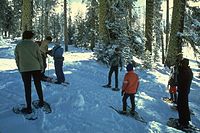Talk:Yosemite National Park/Visitor Info
This should be transwiki'ed properly over to Wikitravel. I'm not very familiar with editing there, so I will leave it to someone else:
Visiting[edit]


Valley camping and lodging[edit]
More often than not guests of Yosemite choose to stay inside Yosemite Valley. Yosemite Valley is the most central region of Yosemite and offers a wide range of attractions. The Valley is of closest proximity to these attractions, to other visitors, and supplies. It hosts the most popular trail heads for waterfalls and domes and offers amazing views of the granite mountains. Thus, when choosing where to stay during a given visit to Yosemite a majority of guests choose the Valley as their temporary living destination. All locations inside the valley, except Camp 4, require prior reservations. Campgrounds are cheap and are what you would expect from normal camping situations, while lodging is pricey and more like what you might find at a hotel (running water, housing structures, etc).
Campgrounds
- Upper Pines
- Lower Pines
- North Pines
- Camp 4
Lodging
- Curry Village
- Housekeeping Camp
- The Ahwahnee Hotel
- Yosemite Lodge
Outside the valley camping and lodging[edit]
Destinations outside the Valley are more remote and geared towards heavy duty camping. The Valley can be very crowded in peak months and camping outside the Valley can serve as a way to separate from the crowds. There exist campgrounds in all directions from the Yosemite Valley floor. Visitors to these campgrounds are not within walking proxmity to the Valley attractions and will need to drive to the Valley. Unlike staying in the Valley where reservations are required, in most cases these campgrounds are all first-come first-served.
Year-Round Campgrounds
- Wawona
- Hodgdon Meadow
Seasonal Campgrounds - closed oct-may depending on conditions
- Bridalveil Creek
- Crane Flat
- Tamarack Flat
- White Wolf
- Yosemite Creek
- Porcupine Flat
- Tuolumne Meadows
Lodging
- Redwoods in Yosemite - Wawona area
- Wawona Hotel
- White Wolf
- Yosemite West
Summer activities[edit]
- Backpacking - Between late spring and early fall, much of the park is open to multiple-day backpack trips. All overnight trips into the back country require a wilderness permit and most require approved bear-resistant food storage. The park wilderness office can provide more information.
- Bicycling - Yosemite Valley contains more than 15 miles (24 km) of bike trails. Under Park Service regulations, bikes are allowed only on paved areas. Mountain biking is not allowed in Yosemite National Park.
- Swimming/Rafting - Generally about midsummer, the Merced River in Yosemite Valley becomes warm enough and is still deep enough to raft down substantial portions. Swinging Bridge and the Vernal Falls pool are common locations for swimming. For those who do not like the cold water, a few heated pools are available. Rafting ranges from drift rafting on the valley floor where guests can rent rafts for $15 (per person) for a slow and gentle 1 hour or more ride down the river. The other option is White Water Rafting on the Merced River.
- Horseback riding - Stables are open in the summer, offering guided rides (generally by mule). Public stables are present in Yosemite Valley, Wawona, and Tuolumne Meadows. Many operations outside Yosemite ride horses into the park. Horses are allowed in many sections of the "backcountry"; however, rangers advise visitors to check with the park wilderness office for more info.
Winter activities[edit]

Much of the park closes due to heavy snow in winter. However, Yosemite Valley is open all year long.
- Skiing - Badger Pass Ski Area (the oldest ski area in California) opens in winter. Skiing is not up to par with Lake Tahoe or Colorado resorts, but has its own charm, being in Yosemite. There are several downhill runs and a ski school. Much of the park is open to cross-country skiing, with several backcountry ski huts open for use. Wilderness permits are required for backcountry overnight ski trips.
- Snowshoeing - Also known as winter hiking, snowshoes are commonly used to experience portions of Yosemite. Many guided snowshoe walks are conducted in winter by the Park Service and by other organizations.
- Ice skating - The Curry Village ice rink is open between November and March. Now smaller than its historical size, the rink still offers room for the figure skaters and those with poor balance. The rink runs 2- to 3-hour sessions and cleans the ice between sessions.
- Bracebridge dinner - An annual holiday event, held since 1927 at The Ahwahnee Hotel, inspired by Washington Irving's descriptions of Squire Bracebridge and English Christmas traditions of the 1700s in his Sketch Book. Between 1929 and 1973, the show was organized by Ansel Adams.
